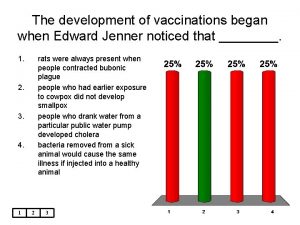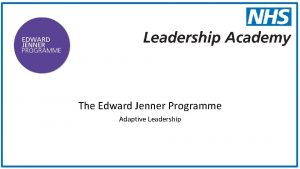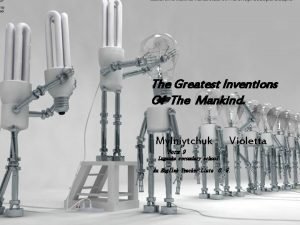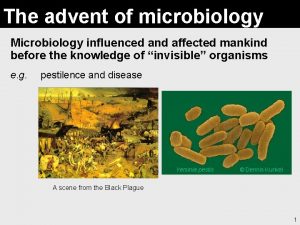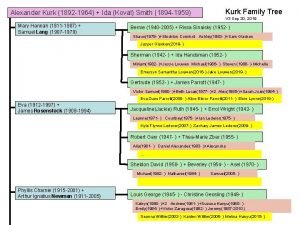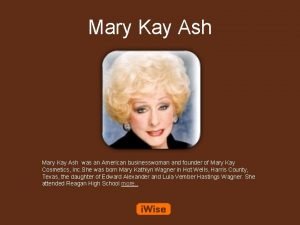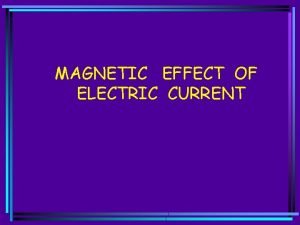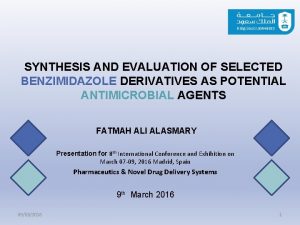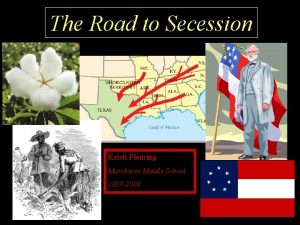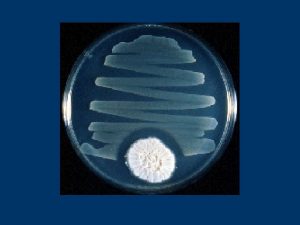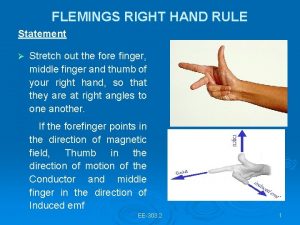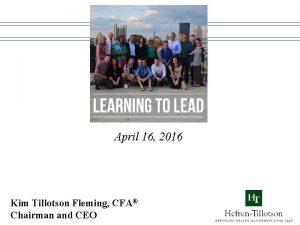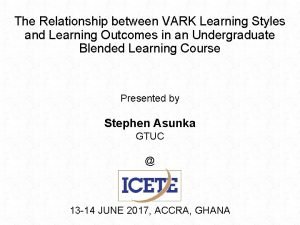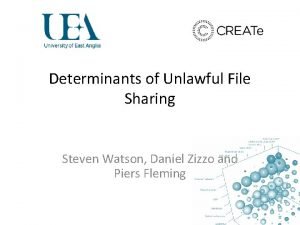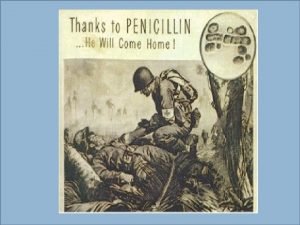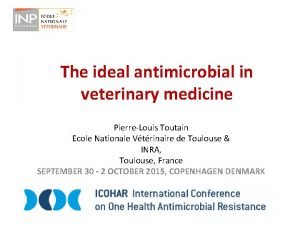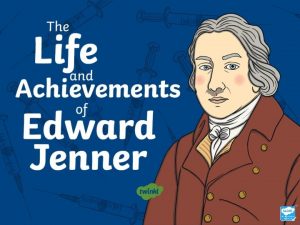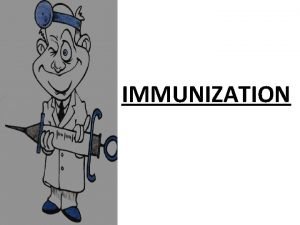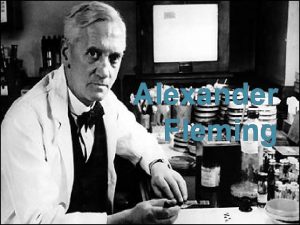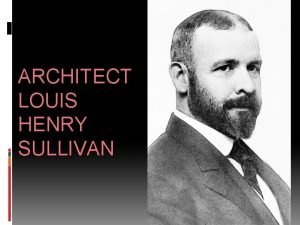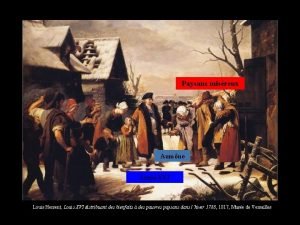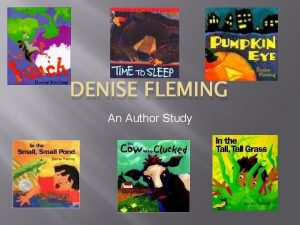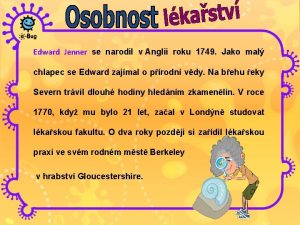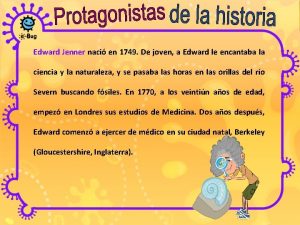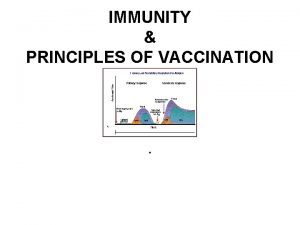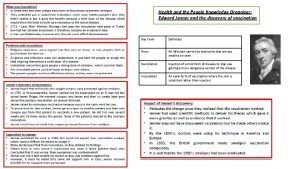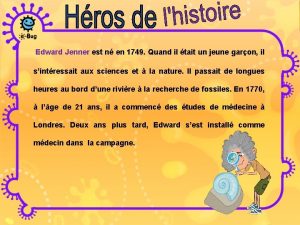s Scienti Content Alexander Fleming Edward Jenner Louis















































- Slides: 47

s Scienti

Content • Alexander Fleming • Edward Jenner • Louis Pasteur • Luigi Galvani • Robert Boyle • Antoine Lavoisier • Charles Coulomb • John Dalton • Joseph John Thompson • Ernest Rutherford • Isaac Newton • Erwin Schrödinger • James Chadwick • Marie Curie • Maria Mayer • Jane Goodall • Gertrude B. Elien • Alessandra Gillani • Ada Lovelace • Rachel Louise Carson

Alexander Fleming

Alexander Fleming was a scientist who worked on a variety of things but he is better known for his famous 1928 experiments in which he was working on bacteria called Staphylococcus which causes sore throats and other illnesses. After leaving some petri dishes with a culture of staphylococcus for some days, he observed that some dishes had mould (fungi) growing in them in addition to bacteria. What was unusual was that the area near the mould had no bacteria around it. He hypothesised that the mould probably produced a chemical that killed the bacteria and carried out further experiments to verify this. Indeed this came up to be correct and the chemical was later called penicillin after the name of the fungus which produces it. In his busy scientific life, Fleming published his findings but did not go ahead to isolate penicillin. Other scientists, Howard Florey and Ernst Chain carried out further experiments and isolated and purified penicillin. Penicillin is a very useful antibiotic which kills bacteria by stopping the formation of their cell walls during reproduction. It is used to treat bacterial diseases. Penicillin was very useful in treating wound infections during the 2 nd World war. There was a race to produce it in large quantities. More antibiotics have been developed similarly since the discovery of penicillin.

Alexander Fleming Reflective thoughts: a) What does this story teach us about scientific discoveries? b) What does Fleming's story teach us about making scientific observations? c) Imagine you were Fleming, what other hypotheses could you have come up with? d) Test Fleming's hypothesis: Make a plan of how you could conduct an investigation to test Fleming's hypothesis. Identify all the 3 kinds of variables (dependent, independent, control). e) Fleming's busy life- Yeeh, but not the end of the story! Florey and Chain's work- what does this teach us about scientific discoveries? Make a few points to brainstorm and discuss with a friend. Is it fair for others to claim credit rather than the original discoverer? Why, why not? f) Penicillin has been produced and used in tonnes since World War 2, i. What have been the problems with its excesssive and indisciminate use? ii. Give and explain to someone a modern day problem/infection caused by this.

Edward Jenner

Edward Jenner Another big moment which started from careful, critical observation is the story of Edward Jenner. In the 1780 s, smallpox was a devastating disease worldwide. Englishman Jenner observed that people who milked cows caught a mild form of smallpox, called cow pox and never contacted smallpox. His hypothesis was that if you are injected with cowpox (mild), it would make the body able to fight off smallpox (deadly). Dangerous experiment! Jenner went on to extract cow pox germs/puss from milkmaid Sarah Nelmes’s sores and deliberately infected local farmer’s son James Phipps. Poor boy! James suffered from cowpox and recovered after 6 weeks. Jenner then deliberately infected James with real deadly smallpox germs. Is this guy crazy? Interestingly, James did not catch smallpox: Hooray!-the world’s first vaccination! This procedure is still in use today and has helped save billions of people from infections.

Louis Pasteur

Louis Pasteur Anyone fancies studying rotting things? Pasteur was interested in fermentation, a chemical reaction which happens when meat, fruits decay, milk sours, alcohol ferments. Concerned that brewers were losing a lot of beer in France due to beer turning sour, Pasteur looked at beer broth under a microscope. Expecting to find only round yeast cells, he also found small rod-shaped cells. This finding led him to conclude that there were ‘bad microbes’ in the broth which cause the beer to turn sour. Pasteur came up with a solution: gently heat the broth to 60 degrees Celsius and allow it to cool before packaging to kill the bad bacteria. This procedure called pasteurisation is still in use today especially with milk hence pasteurised milk!

Galvani and reanimationsome gory stuff from the Italian gang!

Galvani and reanimationsome gory stuff from the Italian gang! What makes us tick? I mean, think, feel, move etc? . . . The nervous system! We could not answer these questions were it not for some gory stuff by Italian Luigi Galvani and his nephew Giovanni Aldini. During frog dissections, Galvani noticed that a frog leg twitched when touched by a scalpel that had been in an electric current. It was like electricity animated/brought to life the frog leg. Further experiments by his nephew Giovanni in London enabled us to understand the relationship between electricity and our nervous and muscular systemsmessages are carried as electric current-aka impulse! In 1818, Giovanni carried out an experiment using a convicted criminal’s body, Matthew Clydesdale who had been hanged. Giovanni and his collaborators passed electrical current through 2 electrodes (metal plates), one embedded in Matthew’s ears and another in the rectum. Sad! The result was amazing! They observed contractions in the muscles of the face, and even opening of one of the eyes. Conclusion: Matthew reanimated! The point is: although grim, the experiment helped with our understanding of the nervous and muscular systems.

Robert Boyle

Robert Boyle (1661) can be considered as the Godfather of chemistry as his work was underpinned by experiment under controlled conditions, precision and accurate observation. His many experiments included the use of vegetable dyes as acid-base indicators and the use of flame tests to detect metals. His pioneering experiments demonstrated that air was essential for respiration, combustion and transmission of sound. He worked extensively on the compressibility of air and the relationship between volume and pressure now called Boyle’s Law or Ideal gas equation (PV = n. RT). This resulted in his findings casting doubt on classical models and he came up with a new definition of the "element". His ideas changed people’s attitudes and paved the way for later scientists like Lavoisier to develop a new chemical revolution.

Antoine Lavoisier

Antoine Lavoisier (1743 -1794) is greatly regarded as the Father of modern chemistry. His work helped disprove the phlogiston theory and hence revolutionaries peoples scientific ideas. Antoine L. Lavoisier discovers that matter is neither created nor destroyed in chemical reactions, the law of conservation of mass. Antoine L. Lavoisier shows that oxygen and hydrogen can be burned together to form water and oxygen as the gas necessary for combustion.

Charles Coulomb

Charles Coulomb worked on applied mechanics but he is best known for his work on electricity and magnetism. He discovered that given two particles separated by a certain distance, the force of attraction or repulsion is directly proportional to the product of the two charges and is inversely proportional to the distance between the two charges.

John Dalton

John Dalton (1803) proposes his atomic model based on ideas previously put forward by Democritus. His theory had three underlying propositions: 1. All substances are made up of small indivisible particles called atoms 2. The atoms of one element are exactly the same but are different from the atoms of other element 3. Atoms combine in simple numerical proportions when elements react together. Apart from his work on atomic theory Dalton also worked on meteorology, composition of gases and colour blindness.

Joseph John Thompson

Joseph John Thompson (1897) discovered the electron in a series of experiments designed to study the nature of electric discharge in a high-vacuum cathode-ray tube. Thompson proposed the plum pudding model which consisted of a sphere of positive charges surrounded by electrons held together by electrostatic forces. His researches also resulted in the development of the mass spectrograph and influenced Ernest Rutherford’s research focus.

Ernest Rutherford

Ernest Rutherford (1871– 1937) was responsible for the discovery of alpha and beta rays, he set forth the laws of radioactive decay, and identified alpha particles as helium nuclei important areas in the fields of radioactivity and nuclear physics. Rutherford’s experiments on the atom demonstrated a dense positively charged central core called the nucleus. Rutherford collaborated very well with other scientists for his discoveries.

Isaac Newton

Isaac Newton - you have probably heard of the story of the apple that fell on his head which helped him formulate the laws of gravitation. These stories are not entirely accurate in description but contain some elemental truths. Newton did extensive work covering the key principles of mathematics, mechanics and gravitation. He identified gravity as the ultimate force controlling the motions of the heavenly bodies detailing the mathematics of orbital motion round centre’s of force.

Joseph John Thompson

Joseph John Thompson (1897) discovered the electron in a series of experiments designed to study the nature of electric discharge in a high-vacuum cathode-ray tube. Thompson proposed the plum pudding model which consisted of a sphere of positive charges surrounded by electrons held together by electrostatic forces. His researches also resulted in the development of the mass spectrograph and influenced Ernest Rutherford’s research focus.

Ernest Rutherford

Ernest Rutherford (1871– 1937) was responsible for the discovery of alpha and beta rays, he set forth the laws of radioactive decay, and identified alpha particles as helium nuclei important areas in the fields of radioactivity and nuclear physics. Rutherford’s experiments on the atom demonstrated a dense positively charged central core called the nucleus. Rutherford collaborated very well with other scientists for his discoveries.

Erwin Schrodinger

Erwin Schrodinger (1925) was the first scientist to devise an equation that could be used to describe the wave pattern of atomic particles. During the twentieth century, it was discovered through experiments that atomic particles behaved in a wave-like pattern. The equation provides a probability of finding particles in a particular region.

James Chadwick

James Chadwick (1932) discovered the neutron. Earlier experiments by Ernest Rutherford had proved the existence of a proton in the nucleus and something else that contributed to the atomic mass. Chadwick’s inspiration came from German physicists who were using radiation to bombard Beryllium atoms. He later improved the experiment and demonstrated the existence of neutrons was involved in the production of the first nuclear bombs.

Marie Curie

Marie Curie (1867 -1934) is a very well-known name in various scientific books, as she undoubtedly made humongous contributions to the field of science. She is popularly known as the "Mother of Modern Physics", and is a known pioneer in radioactivity (she coined the term). Marie Curie was the first woman to be awarded with a Ph. D. in Europe for her subject and later became the first female professor at the Sorbonne. She isolated polonium and radium first, and introduced beta rays in her studies. Marie Curie was also the first woman to win a Nobel Prize and the first person to win it in two different subjects i. e. Physics (1903) and Chemistry (1911).

Maria Mayer

Maria Mayer (1906 -1972) is another lady from the famous female scientists list, is Maria Mayer, a German physicist. She is known for determining the shell structure of an atom, its electronic configuration and the placement of the electrons in the shells. She was also awarded the Nobel Prize for the discovery of a procedure that separated the Uranium isotopes. She is now known to be one of the key discoverers in the formation of the atomic bomb.

Jane Goodall

Jane Goodall Born in England in 1934, Valerie Jane Morris-Goodall, is one of the most famous female scientists. She is known to be an anthropologist, ethologist, primatologist and a UN Messenger of Peace. She is also considered as one among the famous women biologists and is the founder of Jane Goodall Institute. She has worked for about 45 years studying the social and family interactions of chimpanzees.

Gertrude B. Elien

Gertrude B. Elien (1918 -1999) was an American scientist, known to make a major contribution in cancer research. She is known to have invented various anti-cancer drugs which are extremely effective in treating the deadly disease. For these inventions, she was awarded the Nobel Prize in 1988 in Medicine. She was the scientist who invented 6 mercaptopurine (Purinethol), the first ever known treatment for leukemia.

Alessandra Gillani

Alessandra Gillani (1307 -1326) was an anatomist from Italy and the first women to prepare dissections for anatomical studies. Known to be one of the famous women inventors, Alessandra Gillani developed a method of replacing the blood from the corpse with a hardening colored dye, so that the tiniest vessels were made visible for study. Even though there is very little known of her life and her achievements, she can be considered as one of the famous scientists.

Ada Lovelace

Ada Lovelace (1815 -1852) - Her full name was Augusta Ada King, Countess of Lovelace was an English writer. With her name among the other famous women mathematicians, she was later known for her incredible work on the workings of an Analytical Engines as well as the Differential Engines. She was the first person to introduce, how these engines could calculate Bernoulli numbers and thus her contribution in computer technology was worth a mention. She is a great example of one of the famous female scientists for kids.

Rachel Louise Carson

Rachel Louise Carson (1907 -1964), a very common one of the famous scientists names, was a marine biologist from America, and she wrote on nature as well. She studied the effects of DDT on certain crops and the water systems, as there were many problems created due to some synthetic pesticides. She wrote various books like 'The Sea Around Us', 'The Edge of the Sea' and 'Under the Sea Wind' through her life. Her book 'Silent Spring' was her effort to bring to notice the adverse effects of pesticides on nature.
 Edward jenner
Edward jenner The edward jenner programme
The edward jenner programme Industrial revolution
Industrial revolution Why do mexico and peru have primarily catholic populations?
Why do mexico and peru have primarily catholic populations? Directions for producing mhcs come from
Directions for producing mhcs come from Dr. edward jenner nationality
Dr. edward jenner nationality Edward jenner
Edward jenner Edward jenner leadership programme
Edward jenner leadership programme Rudolf dessler
Rudolf dessler Fleming middle school
Fleming middle school Grace stirling morton
Grace stirling morton Tyndallization
Tyndallization Louis vuitton history timeline
Louis vuitton history timeline Jesse james family tree
Jesse james family tree Mary kay ash edward alexander wagner
Mary kay ash edward alexander wagner Cathy jenner
Cathy jenner Katie jenner
Katie jenner Carol jenner
Carol jenner Characteristics of esp
Characteristics of esp Dynamic content vs static content
Dynamic content vs static content State fleming’s left hand rule.
State fleming’s left hand rule. Denise fleming drugs
Denise fleming drugs Martin fleming ibm
Martin fleming ibm Fleming right hand rule
Fleming right hand rule Fleming crim
Fleming crim Eec 22215
Eec 22215 Solar time
Solar time Kristi fleming
Kristi fleming Fleming
Fleming Kevin j fleming
Kevin j fleming Fleming college career services
Fleming college career services Kristi fleming
Kristi fleming April fleming
April fleming Fleming petri dish
Fleming petri dish Right hand rule
Right hand rule Vicki fleming
Vicki fleming Kermin fleming
Kermin fleming Kim tillotson fleming
Kim tillotson fleming Vark inventory
Vark inventory Mundell fleming modeli
Mundell fleming modeli Piers fleming
Piers fleming Erin fleming groucho
Erin fleming groucho Fleming florey chain
Fleming florey chain Nutri opt
Nutri opt 1951 st louis browns
1951 st louis browns Louis xiii accomplishments
Louis xiii accomplishments Pierre louis toutain
Pierre louis toutain Louis xiii accomplishments
Louis xiii accomplishments




